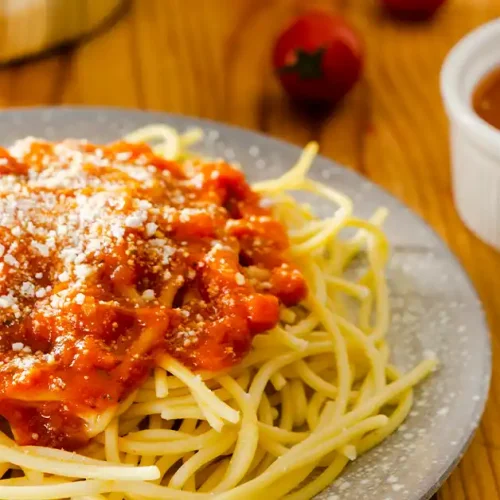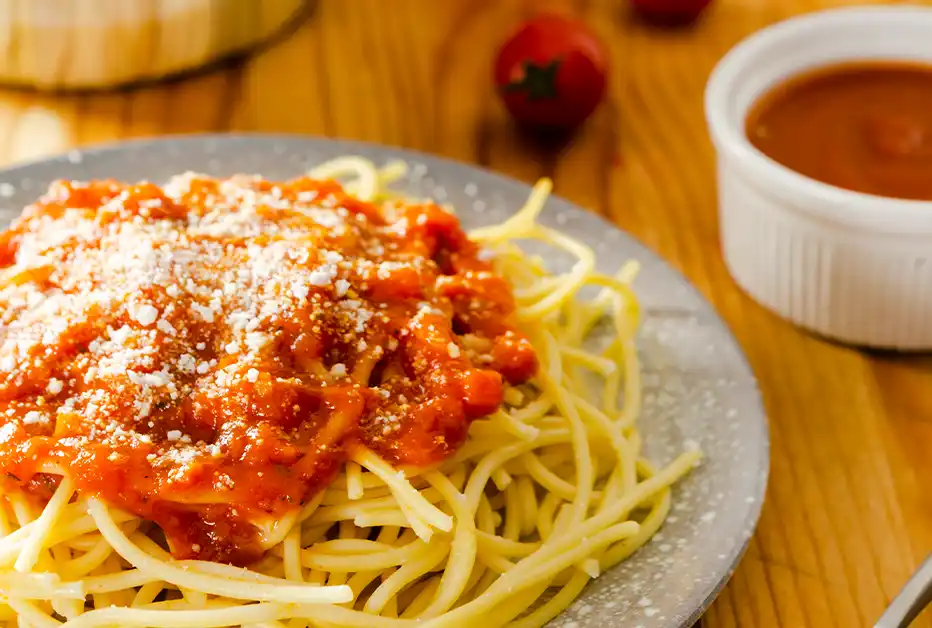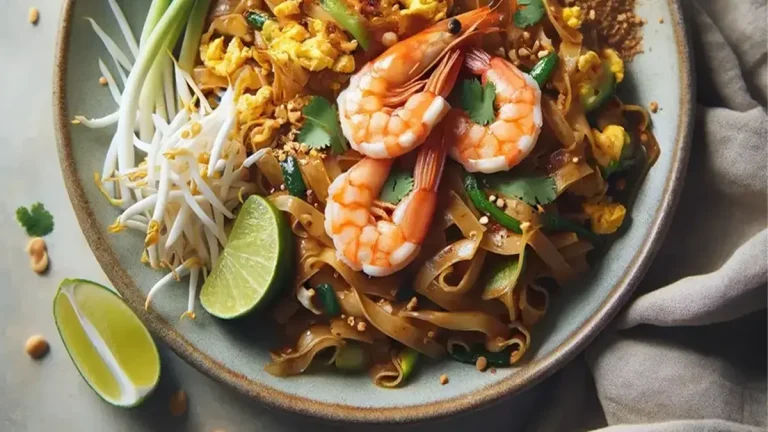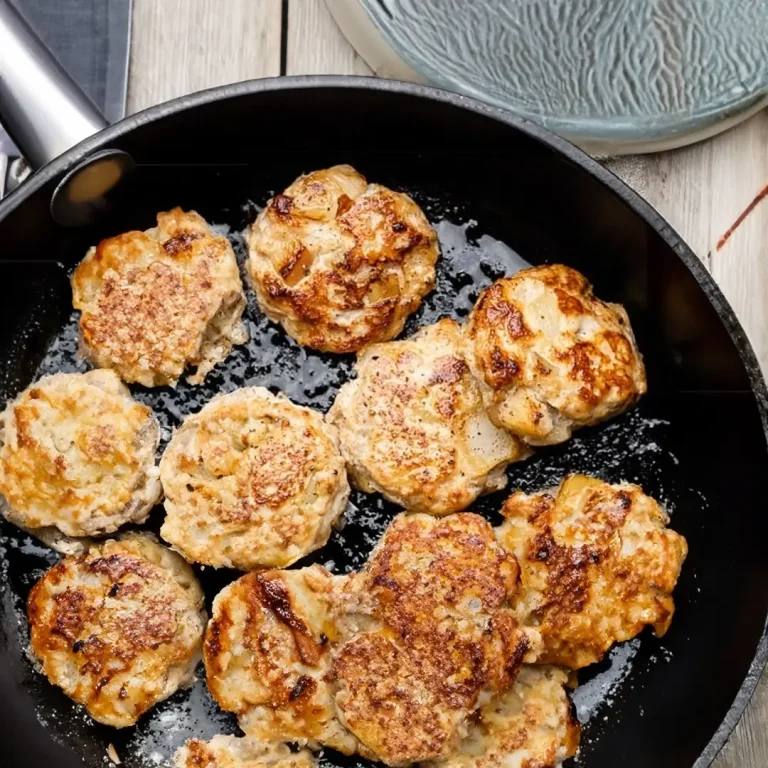Marinara Pasta: a timeless Italian classic that has captured the hearts of food enthusiasts worldwide. This dish, steeped in history, is not just a testament to the simplicity of Italian cooking but also a celebration of flavors that define the essence of a culinary tradition. In this journey through the aromatic lanes of Italy, we delve into the art of crafting the perfect Marinara Pasta.
Marinara sauce, with its rich tomato base, seasoned with herbs like basil and garlic, offers a burst of freshness and tanginess that pairs seamlessly with pasta. This combination is not just a staple in Italian households; it’s a global favorite, versatile enough to be a quick weeknight dinner or a part of a lavish weekend feast.
Embarking on this culinary adventure, we will explore the secrets behind choosing the right ingredients, the nuances of preparation, and the joy of savoring a well-made Marinara Pasta. Let’s unravel the layers of this beloved dish and recreate the magic in our kitchens.
Ingredients and Substitutions
Essential Ingredients for Italian Marinara Pasta
To bring the authentic taste of Italy to your kitchen, the choice of ingredients for Marinara Pasta is crucial. The soul of the dish lies in its sauce, and here are the key components:
- Tomatoes: The foundation of any marinara sauce is tomatoes. Canned San Marzano tomatoes, cherished for their sweet flavor and low acidity, are the gold standard. However, if you can’t find them, any good quality canned plum tomatoes will suffice.
- Herbs and Spices: Fresh basil brings a peppery sweetness, while garlic adds depth and aroma. A hint of oregano can introduce a subtle earthiness.
- Olive Oil: A drizzle of extra-virgin olive oil not only adds richness but also carries the flavors of the herbs and spices.
- Salt and Pepper: Simple seasonings that elevate the natural flavors of the tomatoes and herbs.
Ingredient Substitutions
Marinara Pasta is forgiving and adaptable. Here are some common substitutions:
- Tomatoes: If fresh tomatoes are more accessible, choose ripe, juicy varieties. Crush or blend them to create your sauce base.
- Herbs: Dried basil or oregano can replace fresh herbs, especially in off-seasons. The key is moderation to avoid overpowering the sauce.
- Garlic: In a pinch, garlic powder can substitute for fresh garlic. The flavor profile will be slightly different but still delicious.
- Olive Oil: If extra-virgin olive oil is not available, any neutral-flavored oil can be used. However, the distinct flavor of olive oil is recommended for authenticity.
By understanding these ingredients and their alternatives, you can ensure your Marinara Pasta is delicious every time, regardless of what’s in your pantry.
Step-by-Step Cooking Guide
Preparing the Marinara Sauce
Creating the perfect marinara sauce is an art that lies in its simplicity. Here’s a step-by-step guide to crafting a sauce that’s bursting with flavor:
- Begin with the Base: Heat a generous amount of olive oil in a saucepan over medium heat. Once warm, add finely chopped or crushed garlic and cook until it’s fragrant but not browned. This releases the garlic’s aroma without burning it.
- Tomato Transformation: Add the canned San Marzano tomatoes, including the juice, to the saucepan. For a smoother sauce, crush the tomatoes with a spoon or use a blender beforehand. If using fresh tomatoes, ensure they are adequately crushed or blended.
- Herb Infusion: Stir in freshly chopped basil and a pinch of oregano. If you’re using dried herbs, remember they’re more potent, so use them sparingly.
- Simmer and Season: Let the sauce simmer gently for about 20 to 30 minutes. This slow cooking process allows the flavors to meld together beautifully. Season with salt and pepper to taste. Remember, the key is to taste as you go and adjust the seasoning accordingly.
- Final Touches: Once the sauce reaches the desired consistency and flavor, remove it from heat. Some prefer a chunkier texture, while others enjoy a smoother sauce. You can use a hand blender for a finer texture.
Cooking the Pasta
Choosing the right pasta for your Marinara Sauce is essential. Traditionally, spaghetti or linguine pairs well, but feel free to use your favorite pasta.
- Boiling the Pasta: Bring a large pot of salted water to a boil. Add your chosen pasta and cook it according to the package instructions until al dente. This means the pasta should be firm to the bite.
- Combining with the Sauce: Once the pasta is cooked, drain it while reserving a cup of the pasta water. Toss the pasta in the marinara sauce, adding a bit of the reserved water if needed to adjust the sauce’s consistency.
- Serving: Serve hot, garnished with fresh basil leaves or grated Parmesan cheese for an extra flavor boost.
Marinara Pasta Recipe Variation Ideas
While the classic Marinara Pasta is beloved for its simplicity, it’s also wonderfully versatile. Here are some creative twists you can try:
- Adding Proteins: For a heartier meal, consider adding proteins such as cooked ground beef, meatballs, or even grilled chicken. Stir these into the sauce as it simmers, allowing the flavors to blend seamlessly.
- Incorporating Vegetables: Elevate the nutritional value by adding vegetables like bell peppers, mushrooms, or spinach. Sauté these with garlic before adding the tomatoes to ensure they are well-integrated into the sauce.
- Seafood Delight: Transform your Marinara Pasta into a seafood feast by adding shrimp, clams, or mussels. These should be added towards the end of the sauce cooking process to avoid overcooking them.
- Creamy Twist: For a richer, creamier sauce, stir in a splash of cream or a dollop of ricotta cheese. This addition creates a velvety texture that pairs beautifully with the tangy tomato base.
- Spice it Up: If you enjoy a bit of heat, consider adding red pepper flakes or a dash of cayenne pepper to the sauce. This adds a warm, spicy undertone that can really liven up the dish.
Adapting for Dietary Restrictions
Marinara Pasta can easily be adapted to suit various dietary needs:
- Gluten-Free Options: Use gluten-free pasta alternatives made from rice, quinoa, or legumes. Ensure that the pasta is cooked according to package instructions, as cooking times may vary.
- Vegan Adaptations: To make this dish vegan, simply ensure that no animal-based products like cheeses or meats are added. Opt for plant-based protein options like tofu or tempeh for a fulfilling vegan meal.
- Low-Carb and Keto-Friendly: Replace traditional pasta with spiralized vegetables like zucchini or spaghetti squash. These alternatives offer a low-carb yet satisfying way to enjoy Marinara Pasta.
By experimenting with these variations, you can tailor the classic Marinara Pasta recipe to fit any preference or dietary requirement, making it a truly universal dish.
Serving Suggestions
The presentation and accompaniment of your Marinara Pasta can elevate the dining experience. Here are some suggestions:
- Garnishing: A sprinkle of freshly grated Parmesan or Pecorino Romano cheese adds a salty, umami-rich accent. Fresh basil leaves or a drizzle of extra-virgin olive oil can enhance the aroma and add a touch of elegance.
- Side Dishes: Complement your Marinara Pasta with a side of crusty Italian bread or garlic bread for soaking up the flavorful sauce. A simple green salad dressed with a vinaigrette balances the richness of the pasta.
- Wine Pairing: A glass of Chianti or Sangiovese pairs beautifully with the acidity of the tomatoes. For a lighter option, try a Pinot Grigio or a Sauvignon Blanc.
These serving suggestions will help turn your Marinara Pasta into a delightful and complete meal that’s both satisfying and aesthetically pleasing.
Storage and Reheating
Proper storage and reheating are key to enjoying your Marinara Pasta beyond the initial meal. Here’s how to keep it tasting its best:
- Refrigeration: Store leftover pasta and sauce separately if possible. Place them in airtight containers and refrigerate for up to 3-4 days. This prevents the pasta from absorbing too much sauce and becoming soggy.
- Freezing: For longer storage, freeze the sauce in airtight containers or freezer bags. It can last up to 6 months. It’s best to cook fresh pasta when you’re ready to eat, as cooked pasta can become mushy when frozen and reheated.
- Reheating: Reheat the sauce in a saucepan over medium heat until it’s hot throughout. If the sauce has thickened in the fridge, a splash of water or broth can help bring it back to the right consistency. Cook pasta separately and combine with the heated sauce just before serving.
Properly stored and reheated Marinara Pasta can be a quick and delicious meal for busy days, retaining its flavors and textures.
FAQs
Q1: Can I use red onions instead of yellow in the sauce?
Absolutely! Red onions can be used in Marinara sauce and will impart a slightly sweeter flavor compared to yellow onions. It’s a matter of personal preference.
Q2: Is it possible to use fresh San Marzano tomatoes instead of canned?
Yes, you can use fresh San Marzano tomatoes. If you opt for fresh tomatoes, make sure to blanch and peel them first. This will help in achieving a smoother sauce consistency.
Q3: What are the nutritional concerns and calorie content for Marinara Pasta?
Marinara Pasta is generally a healthier pasta option as it contains no heavy creams or cheeses in the sauce. However, calories can vary based on ingredients and serving sizes. For a lighter version, use whole wheat pasta or vegetable noodles and be mindful of portion sizes.
Q4: How can I make the sauce creamier or spicier?
For a creamier sauce, add a splash of cream, a dollop of ricotta cheese, or even a bit of cream cheese. To add spice, incorporate red pepper flakes, cayenne pepper, or freshly chopped chili peppers during the cooking process.
Q5: Can I add meat to the Marinara sauce?
Yes, adding meat like ground beef, sausage, or meatballs is a great way to add protein and make the dish more substantial. Cook the meat thoroughly before adding it to the sauce.
Q6: How can I make a vegan version of Marinara Pasta?
To make a vegan version, simply avoid adding any animal-based products. Use a vegan pasta and opt for plant-based protein options like tofu or tempeh if desired.
Q7: Can I prepare Marinara sauce in advance?
Yes, Marinara sauce can be made in advance. It stores well in the refrigerator for up to 5 days and can be frozen for up to 6 months. This makes it perfect for meal prep or quick weeknight dinners.
Q8: What pasta goes with marinara sauce?
Marinara sauce is incredibly versatile and pairs well with a variety of pasta shapes. Traditional Italian choices include spaghetti, linguine, and fettuccine, which allow the sauce to cling to their long, thin shapes. For a heartier option, penne or rigatoni with their hollow centers are excellent for holding the sauce.
Recipe Tips
- Dairy-Free: The recipe is dairy-free as long as you do not add the optional Parmesan cheese at the end.
- Vegan: Similarly, the recipe is vegan without the Parmesan cheese. Ensure any added optional ingredients, like wine, are also vegan.
- Vegetarian: The recipe is inherently vegetarian, including with the optional Parmesan cheese.

Marinara Pasta Recipe
Ingredients
- 1 28- ounce can whole peeled San Marzano tomatoes with purée
- 4 cloves garlic peeled and minced
- ¼ cup extra-virgin olive oil
- 1 teaspoon dried oregano or 2 teaspoons fresh, if available
- A handful of fresh basil leaves torn (or 1 teaspoon dried basil)
- Salt and freshly ground black pepper to taste
- 1 pound dried spaghetti or your choice of pasta
- Freshly grated Parmesan cheese for serving (optional)
- Red pepper flakes optional, for added heat
Instructions
- Sauce Preparation: In a large skillet or saucepan, heat olive oil over medium heat. Add minced garlic and sauté until fragrant, about 1-2 minutes. Be careful not to burn the garlic.
- Tomato Preparation: Crush the San Marzano tomatoes by hand or with a spoon and add them to the skillet, including the purée. Add oregano, basil, salt, and pepper. Reduce heat to low and let the sauce simmer for 20-30 minutes, stirring occasionally.
- Pasta Cooking: While the sauce simmers, bring a large pot of salted water to a boil. Add pasta and cook according to package instructions until al dente. Drain the pasta, reserving a cup of pasta water.
- Combining Pasta and Sauce: Add the drained pasta to the sauce, tossing well to coat. If the sauce seems too thick, add a bit of the reserved pasta water to reach desired consistency.
- Final Touches: Serve hot, garnished with Parmesan cheese and a sprinkle of red pepper flakes if desired.







